OEC Old English China OEC Camera EZ Lightstand 3/8" Mountable Speed Ring for Fitting Softbox to Balcar or White Lightning Photo Studio Strobes — Tested with a Chimera Pro II Large Strip Box — Review — and a Comment on Speed Ring (Speedring) Terminology
© 2013 Peter Free
10 May 2013 (stand mount test added 12 May 2013 — further revised 18 May 2013)
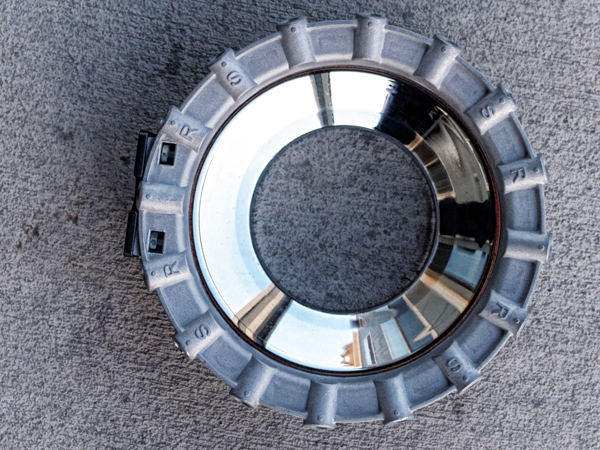
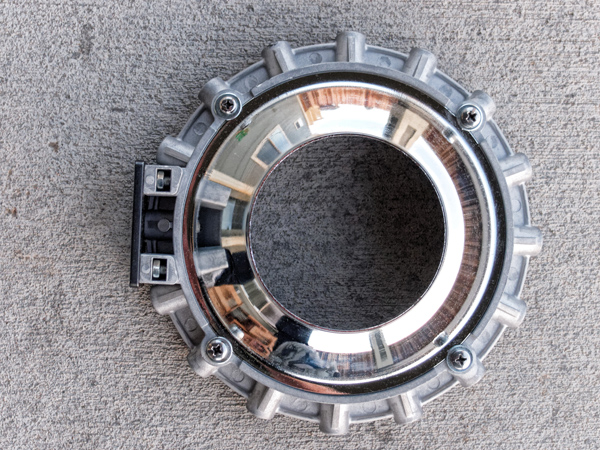
OEC EZ Lightstand speed ring is a surprisingly decent value — but with a hitch
This is a reasonably intelligent design — but the cast aluminum’s coefficient of friction makes softbox assembly and disassembly, under some circumstances, more frustrating than busy location photographers will want.
Limits of this review
I have tested this only with Chimera’s Pro II (4 rod) large strip box and a White Lightning x3200 and x1600. As clumsy and heavy as the x3200 combination is, it provides a reasonable test of the OEC ring’s capability.
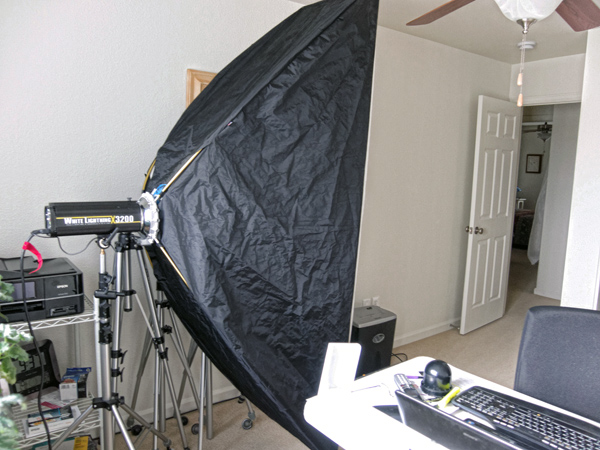
I have not, however, tried the ring with an 8 rod octabox.
What is OEC?
OEC Camera is a photographic accessories company doing business on eBay. It is listed as “Old English China” by PayPal.
The small company has an enviable eBay positive feedback rating of 99.9 percent. I fall into the positive group.
What are photo studio strobe speed rings?
“Speed ring” terminology is confusing because it is imprecise.
Most photographers use the term to refer to a usually two-part device that attaches softbox light modifiers to different brands of studio-intended photo strobe units. This is true regardless of whether those are strobe heads, used with separate cord-linked power packs, or monolights, which have power packs built in.
If you look at the above photographs of the EZ Stand, you will notice that it is a composite of a shiny steel insert and a dull gray aluminum outer ring. The outer ring has receptacle sockets to seat the ends of the rods that hold a softbox’s fabric in the proper shape.
If you examine the photo of the backside of the OEC speed ring (the side that attaches to the strobe), you will notice that it has four screws. These fasten the shiny steel ring to the cast aluminum rod holder ring.
When evaluated in this two-part way, more precise language distinguishes between the “speed ring” and the “adapter”. But, laughably, there is no consensus on which is which.
Part of the confusion arises because one can loosen the inner adapter’s connection to the outer ring, thereby allowing the photographer to spin the light modifier with actually putting any friction pressure on the strobe. Hence, the word, “speed”.
However, we immediately see that the speed attribute can credited to either the adapter or the ring. The adapter because it allows the outer ring to rotate — or the ring, because it does the rotating.
Plume Ltd is alone on the Internet in explicitly telling potential customers what it means by “ring”:
The Plume Flash Ring consists of an outer ring, which will support the diffusion bank, and an inner flash head adapter ring, which mounts to your particular brand of flash "head" or housing.
The outer ring and inner adapter ring are easily assembled and, generally, attach in the same way as your reflectors attach. . . .
The outer ring rotates on the inner adapter ring. Adjust the ease of this rotation by changing the tension on one or all of the thumb nuts.
The inner adapter ring can be easily removed and exchanged with a different inner adapter ring specific to another brand of flash equipment.
© 2012 Plume Limited, Wafer Flash Rings, PlumeLtd.com (2012) (paragraph split)
That kind of clarity is how online technical communication should be done.
Selecting equipment online, as most of us have to do, is not helped by most manufacturers’ and resellers’ reluctance to be clear about what you are getting or will need. Stupidity’s complacence irritates me.
OEC EZ Stand
Mine is for a pair of Paul C. Buff White Lightning strobes.
The OEC unit fits the strobes reasonably well, enough so to mount a Chimera Pro II large strip box that is 210 centimeters (84 inches) by 30 centimeters (21 inches).
I say only “reasonably well” because I think the Balcar mounting system that Paul Buff adopted is less than ideal. This mount is comprised of four hooks on the face of the strobe that slide toward the center of the unit, when a mounting lever (located under the body of the strobe) is pulled against spring pressure.
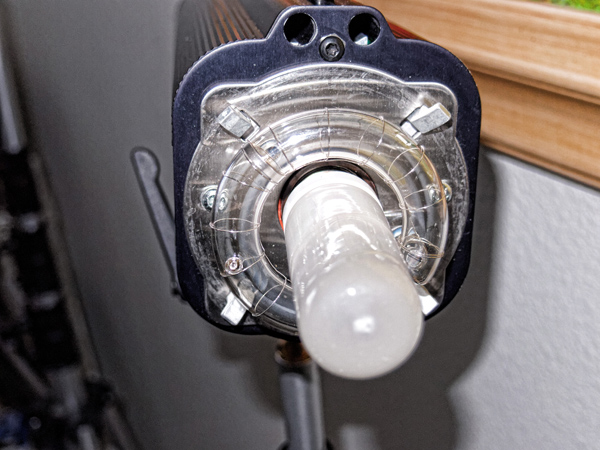
The problem lies in the fact that the spring has to be strong enough to overcome the “moment arm” (meaning leverage) that the faraway ends of the softbox and its overall weight place on the strobe mounting prongs. In the case of big modifiers, like my 210 centimeter (7 foot) Chimera, the Balcar/Buff mount is finicky in seating properly — at least on the OEC ring.
Another problem with the Balcar/Buff design is that mounting requires one to negotiate the speed ring past both modeling bulb and flash tube, preferably without hitting either. That is difficult to do, when mounting something as bulky and clumsy as the large Chimera. (Which, it turns out, is where the EZ Stand’s stand feature comes in handy.)
In consequence of these minor flaws, the OEC speed ring assembly has popped off the strobe a few times — fortunately, while I was standing next to it. Otherwise, the Chimera would have taken the modeling bulb and flash tube with it, on its way to the ground.
On the other hand, once successfully mounted, the OEC ring stays in place. But I would trust it only insofar as I do not try to carry the strobe, light stand, and Chimera assembly to another spot on the floor.
The OEC EZ stand’s main negative — too high a coefficient of rod extraction friction
This is the criticism that may give location photographers pause.
The cast aluminum part of the OEC speed ring is not finely finished. Consequently, when trying to disassemble the softbox, by pulling the Chimera’s four rods out of the ring, the rods’ aluminum ends do not want to slide over the cast aluminum’s rough socket surface. In some instances, it almost feels as if the rods are glued into the sockets.
This occasionally makes disassembling the Chimera a major pain. I have also noticed that the ring’s roughness has already put noticeably wear on the Chimera rod ends.
On the positive side — angled and labeled sockets
The OEZ EZ Stand ring’s sockets are angled inward toward the central axis at a reported 15 degrees. This makes inserting and extracting softbox rods somewhat less difficult than it would otherwise be.
OEC also had the good sense to mark 8 of its 16 sockets with four “R”s and four “S”s. These presumably denote “rectangular” and “square”, which makes it somewhat easier to decide where to insert the rods from different brands and models of boxes.
The not-so-good aspect of these markings is that they are on the forward facing side of the ring. That is the side that faces into the interior of most softbox designs. Which means that you cannot see the Rs and Ss while assembling the box.
OEC apparently did this because the back side of each socket — the side that you see when assembling the softbox — have cast-in supporting struts where the letters should have gone. So, there was no way to cast the letter into the back and visible side of the sockets.
All is not lost. The S designations happen to be opposite the backside’s adapter tightening screws. These one can see while assembling the box.
A peculiarity of the R and S designations
My Chimera strip box, despite being rectangular, maintains its shape better in the OEC ring’s S sockets.
An important note regarding the “stand” part of the OEC speed ring — you need an adapter
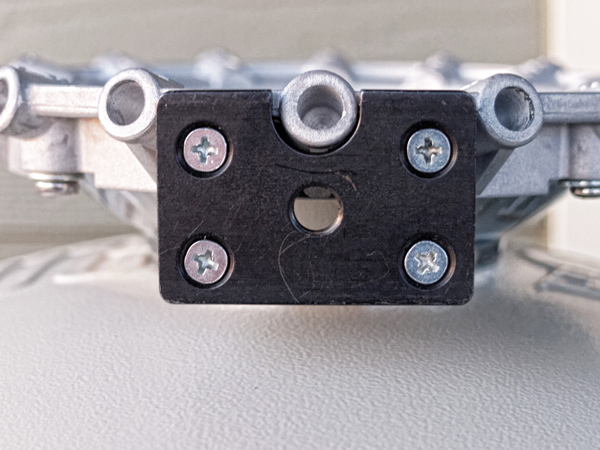
OEC Camera fails to mention that you will need an adapter to use the EZ Stand on a light stand. And OEC does not sell the necessary adapter.
The threaded hole in the flat part of the stand is for a 3/8 inch bolt, like those that come on tripods for connecting tripod heads.
Note
Do not confuse the 3/8 inch bolt with the 1/4 inch bolts and sockets that come with the majority of commonly used tripod heads and cameras.
In order to use the EZ Stand on a conventional 5/8 inch (baby) stud light stand, you will need a Manfrotto 014-38 Rapid Adapter - 5/8" Stud to 3/8" Thread.
Set up this way, the OEC stand will not allow you to tilt your strobe.
To gain the tilting function — and if you are using a light weight strobe head (with a separate power pack) or a small monolight — you may be able to get away with adding a tilting Matthews Knuckle Head between the Manfrotto adapter and the light stand’s 5/8 inch stud.
Keep in mind that the Knuckle Head’s weight supporting limit is 15 pounds. This limit makes it questionable whether the Matthews gizmo would reliably support a 7 pound White Lightning x3200, the 1.1 pound OEC ring, and the comparatively heavy 210 centimeter Chimera in a tilted position.
Lacking the necessary adapter (to use the ring on a standard 5/8 inch stud light stand), I mounted the EZ Stand speed ring directly to the 3/8th inch bolt of a decades old, heavy duty Gitzo tripod. After that went well, I mounted it on a lightweight Bogen 3001. The Bogen is essentially the equivalent of today’s Manfrotto Manfrotto’s 293.
If you do this, be aware that if the strobe mount lets go — while the EZ Stand is directly mounted to the stand or tripod — the monolight is going to hit the floor with force.
Mounting the box to the tripod-mounted ring worked better for me than trying to mount the ring onto the box rods with the Chimera face down on the floor.
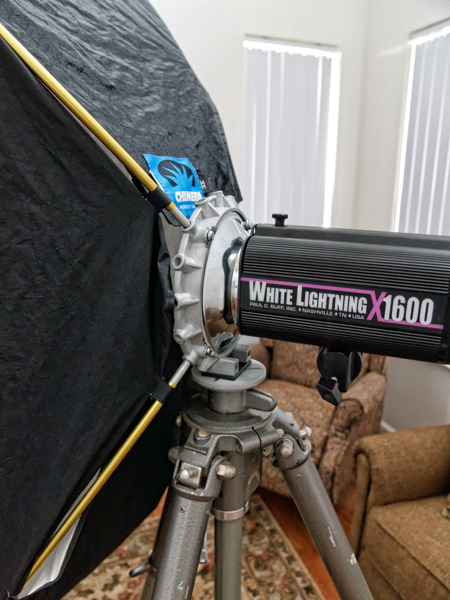
Although I did the initial stand feature test using the x1600, I later discovered that the much heavier x3200 also mounts reliably. I just have to be sure to twist the strobe onto the OEC ring to ensure that it has seated properly.
A pleasing aspect of the EZ Stand
As I mentioned above, getting the OEC EZ Stand onto the Chimera with the box face down on the floor is somewhat more time consuming than location photographers might wish. But when I got accustomed to using the OEC ring's stand feature, things became surprisingly easier.
I found it easier to mount the box onto the ring, while the ring was already mounted on a standing tripod.
Recommended — but with caveats
OEC’s EZ Stand speed ring assembly is a good value for the money. And OEC’s efficiency in processing and delivering my order was exemplary.
On the other hand, the high coefficient of friction inside the ring’s sockets is less than ideal.
The stand feature of the OEC speed ring is also of questionable value for people, who want to retain the ability to tilt the strobe and modifier combination, without spending a bunch more money on more adapters.
That said, I found the EZ stand feature especially appealing, when using my near-ceiling height Chimera strip box. In the tiny room that I am forced to use it, tilt is not of much value.
Overall, the OEC ring is a decent value at less than half the going rate for most manufacturer-specific rings.
 PeteFree.com
PeteFree.com